I wrote this race report in October and am republishing it here to get the word out about one of the best Bay Area trail runs. This 50-miler and its companion race, the Golden Hills Marathon, will take place October 8, 2011. Check out the website’s map and the East Bay Regional Park District’s Chabot, Redwood, Sibley, and Tilden maps to run all or part of this awe-inspiring tour of the Berkeley and Oakland hills.
I have never been in such a morose mood during a race as I was around Mile 26 in my first 50-miler, the October 9 Dick Collins Firetrails 50. The race starts at Lake Chabot in Castro Valley, traverses the glorious East Bay Regional Park District greenbelt, turns around at Tilden Park’s Lone Oak picnic area in North Berkeley, and heads back to the lake, with 7800 feet of elevation gain along the way.
See the middle part of this elevation profile, where the course plummets between the two peaks? That’s where my spirits plummeted too:
My body felt like a punching bag with every step on the descent to the turnaround point. My toes erupted with blisters that felt as big as cherry tomatoes. I kept looking at my watch and obsessing about how I was missing my goal—I wanted to reach the turnaround in as close to 4 hours as possible, and it was, what, 4:17? That’s not what I was hoping for. And I had to take a break to spend a couple of minutes in the portapotty. I felt physically lousy and mentally wrecked, the polar opposite of the share-the-love-and-grasp-the-meaning-of-life runner’s high I felt during recent running events.
I absolutely did not want to run back to the finish and wasn’t sure I could even if I had to. I ran 26 miles; couldn’t I be done? I’m a marathoner, not an ultrarunner. Not even the warm words of encouragement along the course from luminaries of ultrarunning, like Ann Trason and John Medinger, cheered me up—if anything, it made me feel like a party crasher who didn’t belong in this endurance scene.
I was the Wicked Witch of the East Bay, such a dark cloud on the sunny day that as I headed up the hill from the aid station, I snapped at two women hikers and their sweet pack of four dogs who came up to sniff my legs, “Would you mind moving your dogs out of my way?”
Just then, iRunFar‘s Bryon Powell, with his flaming orange hair and oversize grin, came galloping toward me with a couple of other guys. They were approaching the turnaround point as carefree as kids running to be first in line at an amusement park ride. Bryon had slept at our house the night before, needing a couch on which to crash since he’s from out of town, and I flashed back on him at 5:15 a.m., eating a bowl of Cheerios at my table while I unloaded the dishwasher. When I admitted to him then that I was freaking out about my performance, he looked at me as if I were extraterrestrial and he spoke slowly and clearly, as if I were mentally challenged. “You’re doing your first 50. Just finish and have fun.”
Yeah, duh, I told myself there in the kitchen. Look at Bryon: an ultrarunner coming back from injury who hasn’t run more than 20 miles in who knows how long, who signed up for the 50 just for the heck of it, just to finish and try to get a Western States qualifier. Yeah, that’s the spirit. Yeah, why couldn’t I feel that way out on the course?
Because I wasn’t having fun, that was the problem. I was pushing myself so hard that I was keeping any fun out of reach.
Something had gone wrong after an auspicious beginning. I was doing better than fine for the first part of the race, through Skyline Gate (Mile 15). My legs felt zippy, and I followed a prudent plan for drinking and getting calories.
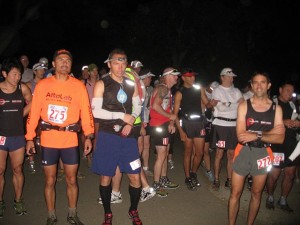
I felt great at the 6:30 a.m. start in the darkness (I'm the person with the headlamp peeking out behind the right shoulder of the guy in orange). Photo by Jean Pommier.
But then, too early in the day, everything—shoulders, back, knees, ankles—started to ache and stiffen, as though I suddenly aged 20 years and began to develop arthritis. My feet started to blister, which never happened in training runs, and my confidence was rattled. Coming up a very challenging scramble approaching Sibley, where the single-track’s footing is so loose and steep that everyone has to duck-walk up to keep from sliding back, I was puzzling over my physical condition and staring down at the ground when WHACK! a low-hanging tree branch clocked me in the head.
I shrieked and closed my eyes to block out the pain, visualizing a tourist shop we visited last May in Switzerland with a wall of cuckoo clocks, where so many cuckoo birds kept popping out of the carved clocks and chirping while bells kept chiming, and I imagined animated stars crowning my skull.
There was nothing to do but keep running and ignore the headache. But I couldn’t get my groove back. Around Mile 20 on the approach to the Steam Trains aid station, the lead runners who were competing in the Golden Hills Marathon started barreling down the trail toward us 50-mile runners. (The Golden Hills Marathon is the companion race to the Firetrails 50; the marathon runners do a point-to-point from Tilden to Lake Chabot.) Caren Spore, followed closely by two other women runners, was sprinting at what seemed like a 5K pace. I knew she was on her way to smashing my 2007 Golden Hills course record, and instead of feeling inspired by the marathoners’ energy, I fell deeper into a funk by dwelling on how slow I felt now compared to how fast I was three years ago when I set that record.
By the time I got to Steam Trains, I was not a happy camper. Then I got through the turnaround and saw Bryon and the scores of others coming down the trail behind me. I heard his words again, “You’re doing your first 50. Just finish and have fun.” It seems so simple, so obvious. But I had prepared meticulously for four months, I knew the course intimately, I had raced shorter distances on it many times, and I had calculated what I should be able to physically accomplish and therefore set the bar quite high—all of which robbed the experience of simplicity. I had taken a favorite phrase of my coach, “Preparation is the key to success,” to a counterproductive extreme, “Preparation is the key to obsess.”
The thought came to me: if Bryon can do it, so can I. And pretty soon I saw Keith, who was beaming and running steadily. He gave me a buoyant hello. If Keith can do it, so can I. And then came Jennifer, as friendly as always, striding strong. If she can do it, so can I.
As I switched into post-26-mile survival mode, shelving my time goal of 8:15 and single-mindedly striving to regain the confidence that I could just run/hike steadily to the finish, that became my mantra: If they can do it, so can I. I started to shake off some of my negativity by seeing myself as one of many in a great event in which the collective spirit—that we’re all in this together—trumps individual weakness.
I really started to take a closer look at the other runners on the course who were approaching the turnaround point while I climbed back up Volmer Peak on the return, and the majority of faces mirrored the positive attitudes of Bryon, Keith and Jennifer. They understood the nature of this endurance sport far better than I. They had cultivated the patience and perseverance that a rookie like me still needed to learn the hard way. Being a student and groupie of ultrarunning for several years could not prepare me for what I had to learn firsthand. I felt baptized into the sport when I said in my head, “Oh, so this is what it’s all about—this is what I signed up for. It’s supposed to hurt. It’s supposed to be hard. I’m supposed to be more like a tortoise and less like a hare-brained hare.”
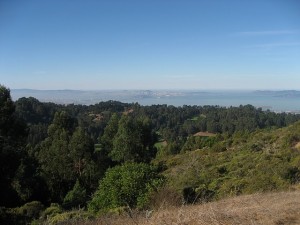
A view of San Francisco from the Firetrails 50 course peak—a vista that helped me get out of my funk. Photo by Jean Pommier.
I caught up with a good number of guys I respect, hit the 31 mile (50K) mark in 5:15, and realized that for all my bellyaching, I was running a respectable pace. I spent the next ten miles cruising on the very runnable Stream Trail pondering all sorts of things, like being Crowie Alexander, the two-time Ironman world champion who on this same morning was in Kona trying to defend his title (he ended up finishing fourth). What would it be like to run a 2:40 marathon after those hellacious swim and bike legs? And what would it be like to have all the sponsorship pressure that goes with making a living as a professional competitor? And how weird is it that I spent a night with him back in February, which was a big part of what inspired me to seriously consider signing up for this very event? Thinking of the strength and equanimity he brings to his competitions helped renew my strength and enhanced my appreciation for this blissfully uncomplicated, backwoods sport a world away from the high-stakes, elaborate Ironman production.
I negotiated the steps and turns of the tricky Golden Spike section and refueled at the Big Bear aid station to make a push on the final big hill, the MacDonald Grade, at mile 41.5. By this time it was around 12:30 p.m. and the heat on the exposed fire road made my shoulders crisp. I put everything I had into running up the mile-plus climb of MacDonald—I run it all the time, but never with 41 miles on my feet—and I succumbed to hiking part of the way. Big thoughts evaporated as the focus narrowed to one foot in front of the other, stay awake, breathe. I passed a succession of three guys who walked with the dazed, hollow look of refugees. They would pause to place their hands on knees and hunch over to get blood back in the brain or to stretch out a cramp.
I knew the worst was behind me when I ran down the backside of the grade and felt certain I could run a 10K—not fast, not pretty, but steadily. Maybe my renewed energy had to do with the fact my Garmin watch battery died at the Bort Meadow aid station, Mile 44, so I had to run the final six miles with no idea of time or pace. In other words, I was liberated. I passed more guys on the uphills coming around Lake Chabot. The back ache, the Achilles tightness, the toe blisters, the kneecap twinges all blended into a white noise of discomfort that could be tuned out.
Instead of finishing a 50-miler, I tricked myself into thinking I was finishing the Golden Hills Marathon again and rediscovered the mojo of the final mile, when sprinting becomes possible and actually brings pleasure. Where does it come from, that hidden reserve, that higher gear, and why must we put ourselves through so much to access it? I saw the clock read 8:31 at the finish and felt giddy as I crossed. When I pointed at the clock and snapped my fingers, saying, “Ah, shoot, not 8:30?” I was laughing and my tone was self-mocking.
I was absolutely elated to be done and proud to have finished. I saw my kids, under the care of our friend Cheryl, and reunited with Morgan, who had finished the Golden Hills Marathon after a heroic turn of events that made my race seem less important.
The results board revealed I was 31st overall (out of 235 finishers) and 5th woman. I hugged and thanked Ann Trason and then helped myself to a piece of her homemade pumpkin cheesecake. I delighted in a goody bag of an age-group prize that I got by the fluke of protocol. I didn’t think I’d get an age division award because Bree Lambert, the incredible women’s winner with a time of 8:04, is 42 and hence in my group, but Ann explained that overall winners can’t “double dip” in the age-group prize category. OK, thanks, I’ll take it!
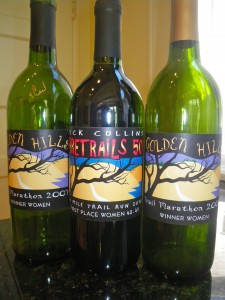
The Firetrails 50 age group "trophy," center, between my Golden Hills Marathon prizes from 2006 and 2007.
Ann and Carl give wine glasses to each finisher and a bottle of wine to each division and overall winner—one of the many special touches of this classic event. I’m looking forward to opening my bottle in the not-too-distant future to toast the race directors, Morgan, and, yes, me.
For more info on the Dick Collins Firetrails 50 event, see the article I wrote for Trail Runner magazine in 2008.

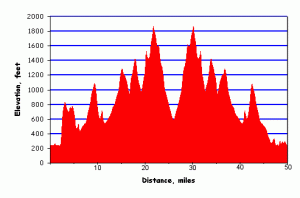
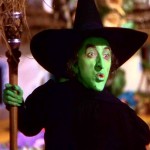
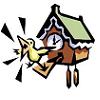
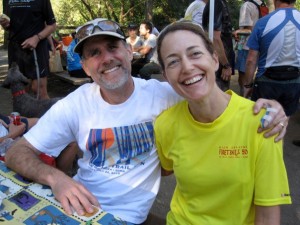
Comments are closed.